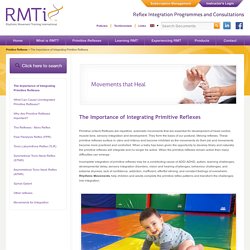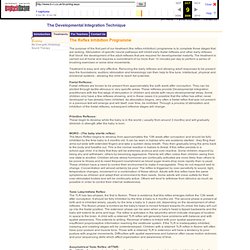

Primitive reflexes 1 month old infant. Spinal Galant: "Angels in the Snow" Primitive Reflex Symmetrical Tonic Neck Reflex for Autism, ADD, ADHD, Dyslexia, OCD Exercise 5 of 8. Developmental Integration Technique (DIT) Guilderland Central Schools Physical Therapy Department. The Importance of Integrating Primitive Reflexes. Primitive (infant) Reflexes are repetitive, automatic movements that are essential for development of head control, muscle tone, sensory integration and development.

They form the basis of our postural, lifelong reflexes. These primitive reflexes surface in utero and infancy and become inhibited as the movements do their job and movements become more practiced and controlled. When a baby has been given the opportunity to develop freely and naturally the primitive reflexes will integrate and no longer be active. When the primitive reflexes remain active then many difficulties can emerge.
Incomplete integration of primitive reflexes may be a contributing cause of ADD/ ADHD, autism, learning challenges, developmental delay, sensory integration disorders, vision and hearing challenges, behaviour challenges, and extreme shyness, lack of confidence, addiction, inefficient, effortful striving, and constant feelings of overwhelm. Treating dyslexia, dyspraxia, ADHD and other developmental problems. Specific techniques &tips to integrate primitive reflexes. Retained Neonatal Reflexes. THE DEVELOPMENTAL INTEGRATION TECHNIQUE Website : Brushing. The purpose of the first part of our treatment (the reflex-inhibition) programme is to complete those stages that are lacking.

Stimulation of specific neural pathways will inhibit early foetal reflexes and other early reflexes that 'block' the development of the adult reflexes that are required for developmental maturity. The treatment is carried out at home and requires a commitment of no more than 10 minutes per day to perform a series of brushing exercises or some slow movements. Treatment is easy and very effective. Removing the early reflexes and allowing adult responses to be present lays the foundations; auditory stimulation and kinesiology can then help to fine tune, intellectual, physical and emotional systems - allowing the child to reach full potential. Foetal Reflexes: Foetal reflexes are known to be present from approximately the sixth week after conception. Tonic Labyrinthine Reflex: The TLR has two-phases, the first in flexion. ResearchonReflexes.pdf. Alexander Technique - Body Mind Balance. Feldenkrais Method - Awareness through Movement.
Anat Baniel Method - NeuroMovement. Vojta Method - Reflex development. Vojta.com. Mirror box - Ramachandran. Mirror box by Ramachandran. A diagrammatic explanation of the mirror box.

The patient places the good limb into one side of the box (in this case the right hand) and the amputated limb into the other side. Due to the mirror, the patient sees a reflection of the good hand where the missing limb would be (indicated in lower contrast). The patient thus receives artificial visual feedback that the "resurrected" limb is now moving when they move the good hand. See text for more details. A mirror box is a box with two mirrors in the center (one facing each way), invented by Vilayanur S. In a mirror box the patient places the good limb into one side, and the stump into the other. Ramachandran's theory was challenged by a 2010 research study conducted by Marian Michielsen of the University Medical Center, Rotterdam.
A diagram of a mirror box. Effectiveness[edit] A number of small scale research studies have shown encouraging results, however there is no current consensus as to the effectiveness of mirror therapy. Padovan Method - Neuronal plasticity. Auricula Method - Autisme. Biraud Method - Réalignement Postural. Castillo Morales Method - Communication. Petö Method - Conductive education. | Imprimer | C'est une approche d'éducation intégrée des enfants et des adultes porteurs de handicaps secondaires à des lésions cérébrales.

Elle est imaginée par Andräs Petö,médecin pédagogue hongrois dans les années 40. L'éducation conductive permet à l'enfant cérébrolésé de mobiliser, par un travail d'apprentissage guidé, ses ressources neuro motrices, cognitives et sensorielles et ainsi d'apprendre à trouver des stratégies lui permettant de résoudre les problèmes auxquels il est confronté tout au long de la journée. "Chacun doit terminer ce qu'il a commencé" Ce principe s'applique aussi aux personnes handicapées qui semblent si souvent ne pas savoir finir une tâche. La façon d'y parvenir doit être imaginée ; C'est l'ambition de l'éducation conductive. Les résultats des recherches actuelles sur les différentes modalités de la plasticité cérébrale ainsi que certaines théories de l'apprentissage trouvent un écho dans la pratique de l'éducation conductive. Deveny Method - Analytical gymnastics. Home MEDEK. Kinedoc - Base documentaire de la masso-kinésithérapie/physiothérapie francophone.